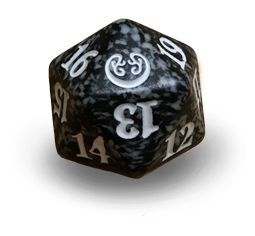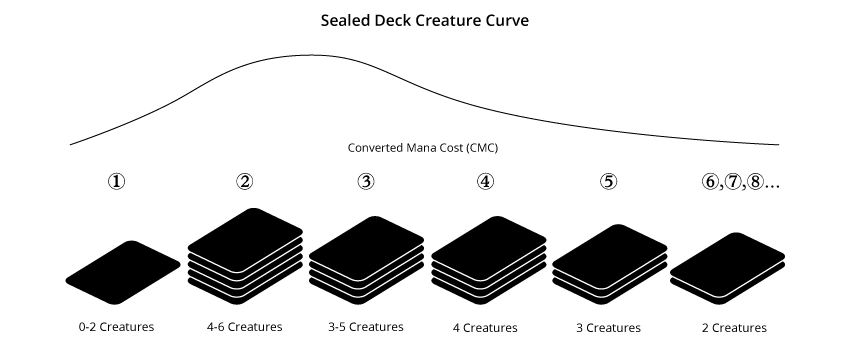INVENTOR'S TOOLKIT
When you head into the Prerelease and sit down to play, you'll be handed a quite, well, inventive new deck box containing everything you need to build your deck. Check out this marvel of engineering!

Everything you will be playing with comes right in the box—plus a few bonus perks.
For example, you'll find this lovely spindown D20 you'll get to walk away with:

Most important out of everything inside your Prerelease pack are the six booster packs that will give you the cards you need to build your Sealed deck, plus your shiny bonus Prerelease card. (Which could be any rare or mythic rare in the set!)
First things first: crack open those booster packs! Then you'll have a stack of cards.
So...what now?
It's time to build your deck, of course!
Sealed Deck is a little different from normal deck building. You get to build a deck only using the cards in front of you, plus as many basic lands as you'd like. Also, unlike a normal Constructed deck where the minimum deck size is 60, you only have to play 40 cards.
The first thing you're going to want to do is figure out a method to pick which colors you'll be playing. I recommend playing two colors.
Some things that may draw you into specific colors are:
A really strong rare you're excited about
Plenty of "removal" cards that can deal with your opponent's creatures
A lot of playable cards in that color
A good "mana curve" in that color—meaning lots of creatures of different costs
Ideally, the colors you pick will have all four, but if two or three of those are true that's plenty good.
Whatever your method, you're going to need to narrow down what you're playing. If you get stuck at the Prerelease, feel free to ask the players around you for help. (You are allowed to do this at a Prerelease—everyone is there to make sure it's a fun event!)
But whatever your method, now you have your colors down. From there, how do you take everything you have and figure out which 22–23 cards you're going to want to put in your deck?
Here's one process that may help!
First, lay your creatures out in mana-cost order. This helps you see what creatures you're going to potentially have available to cast at each part of the game. (Don't lay your noncreatures out at this point unless they're cards you are planning to play as soon as you have that much mana—for example, you will generally cast a Metalspinner's Puzzleknot on turn two, whereas Harnessed Lightning isn't usually a turn-two play.)
A good "mana curve" of creatures is crucial to a successful Sealed deck. You don't want to have a ton of cards at any single spot in the curve. It's important for you to be able to have a good mix so you can play your cheap spells in the early game and your expensive spells in the late game. As a very general rule for Limited, I would look to play something like this:
1 mana: 0–2 creatures
2 mana: 4–6 creatures
3 mana: 3–5 creatures
4 mana: 4 creatures
5 mana: 3 creatures
6+ mana: 1–2 creatures

That's far from hard and fast, but it's a good place to start. Cull your creatures down to these numbers by choosing your favorites.
Now that you have your core creature base figured out, it's time to add in spells! Pick your favorites among your colors to bring your deck to 22 or 23 cards, and then you're good to go from the spell side.
The spells you're going to want the most are what are called "removal spells"—these are the spells that permanently neutralize your opponent's creatures, by either dealing damage, keeping them tapped, or just straight-up destroying them. Sealed Deck Magic is all about creatures, so you'll want to play most of the cards in your colors that can get rid of your opponent's creatures.
Kaladesh is particularly interesting, in that it has a high number of artifacts compared to a typicalMagic set. You're going to have more artifact options than normal. Unless these are also creatures, they should be counted among your noncreature spells, so narrow it down to the ones you really want to be playing with.
Additionally, Kaladesh introduces Vehicles! More on exactly how those work later (or you can just click here), but they're sort of like creatures. However, you do need (other) creatures to be able to crew them. If you play a couple Vehicles, you can treat them like creatures for your creature count, but be wary of playing too many lest you end up with a board full of Vehicles and nothing to drive them!
Interested in more tips? Here are a few more things to keep in mind for deck building:
You can play more than 40 cards, but you really should stick to 40 if you can. Every card you play past 40 just means it's that much less likely you're going to draw that awesome rare you put in your deck!
The land ratio you're looking at should be about seventeen lands to 23 nonlands. This isn't right 100% of the time, but most Limited decks end up looking like this, and, in general, it's what I would want to have.
Play a mix of cheap-to-cast and expensive-to-cast cards. If you have all cheap, small creatures, then a single big creature can shut you down. Likewise, if you have all expensive, large creatures, you risk getting run over first. Stick to a mix that focuses on the two-, three-, four-, and five-casting-cost creatures. More games of Sealed Deck are won by casting a creature every turn starting on turn two or three than any other way.
Evasion is important! Often, Sealed Deck games will get into stalls where both players have a lot of creatures and neither player can attack very well. Creatures with abilities like flying ensure that you can break through these creature stalls.
Other than that - come along and have a great game or two!!!

No comments:
Post a Comment